How to Pop Your Ears Safely

How to Pop Your Ears Safely
5 mins
Published: 17 July 2025
17 July 2025
How to Pop Your Ears Safely
Have you ever experienced that blocked, muffled sensation in your ears during a flight, mountain drive, or while recovering from a cold? This common discomfort often results from a pressure imbalance between your middle ear and the external environment. In this blog, we'll explore safe and simple methods to "pop" your ears, helping you restore clear hearing and comfort.
Why Do Our Ears Pop?
Our ears pop when the Eustachian tube - a small passage connecting your middle ear to the back of your nose - opens to equalise air pressure.1 You might notice it as a soft “pop” followed by improved hearing or a sense of relief. Common situations where ears need to pop include:
- Flying: Particularly during take-off or landing, when cabin pressure changes rapidly.
- Scuba diving or swimming: The pressure underwater can affect the ears.
- Driving at high altitudes: Roads through hills or mountains can trigger ear pressure changes.
- Having a cold or sinus infection: Congestion can block the Eustachian tubes, trapping pressure.
If your ears are unable to equalise pressure, this can lead to discomfort, temporary hearing loss, or a feeling of fullness in the ear.2
Safe Methods To Pop Your Ears
Not all popping methods are safe and effective, however these research-backed techniques are gentle on the ears and easy to try at home or on the go.
Yawning
Yawning might not sound all that effective, but it stretches the muscles around your eustachian tubes to allow air flow back into your middle ear. This in turn helps to equalise the pressure and see your ears “pop” gently.1 Stretching your mouth wide and taking a deep breath can also work.
The Valsalva Maneuver
This method involves gently blowing while pinching your nose and keeping your mouth closed, helping to create pressure behind your nose that can open your eustachian tubes.3 Simply take a breath, pinch your nose shut, close your mouth, and gently blow.
The Toynbee Maneuver
This technique combines swallowing and holding your nose. To perform it, simply pinch your nose shut and swallow at the same time. Many people find this technique more comfortable and just as effective as the Valsalva method.4
Frenzel Maneuver
This is typically used by scuba divers to help relieve their ear pressure. It creates some pressure in your nasal cavities that helps open up the eustachian tubes.4 To perform this method, simply pinch your nose closed and close your mouth. You’ll then try to make a “K” sound while keeping your mouth and nose closed.
Chewing Gum
Chewing gum can help stimulate jaw movement and swallowing, which is great during altitude changes on a plane or a hilly road trip.1
When Not To Pop Your Ears
Sometimes, popping your ears isn’t the best idea - particularly if your ears are inflamed or infected.5 Avoid trying to pop your ears if:
- You have a severe cold or sinus infection
- You experience a sharp pain when trying to pop your ears
- You’ve had recent ear surgery or a perforated eardrum
In these cases, forcing your ears to pop may do more harm than good. Instead, let your ears rest, stay hydrated, and use decongestants only if recommended by a healthcare professional.
Popping your ears should never be painful. If you're experiencing discomfort or persistent blockage, it's advisable to consult a hearing care professional. Our experienced team can assess your ear health and recommend safe, effective methods to relieve any issues.
Booking an appointment at your local Connect Hearing clinic ensures you receive personalised care to restore clear hearing and maintain optimal ear health.
References:
StatPearls Publishing (17 March 2023), Physiology, Eustachian Tube Function, National Library of Medicine, accessed 27 May, 2025.
Cleveland Clinic (10 October 2024), Eustachian Tube Dysfunction, https://my.clevelandclinic.org, accessed 27 May 2025.
Clinical and Experimental Otorhinolaryngology (6 June 2017), Analysis of Eustachian Tube Dysfunction by Dynamic Slow Motion Video Endoscopy and Eustachian Tube Dysfunction Questionnaire in Chronic Otitis Media, Clinical and Experimental Otorhinolaryngology, accessed 27 May 2025.
European Archives of Oto-Rhino-Laryngology (6 June 2021), Prospective study on the Eustachian tube function during Frenzel maneuver in a hypobaric/hyperbaric pressure chamber, Springer Nature Link, accessed 27 May 2025.
The Laryngoscope (4 October 2021), Medical Management for Eustachian Tube Dysfunction in Adults: A Systematic Review and Meta-Analysis, Wiley Online Library, accessed 27 May 2025.
Author
Connect Hearing
Reviewed by:
Connect HearingSonova
.png?branch=web_prod)
.png?branch=web_prod)